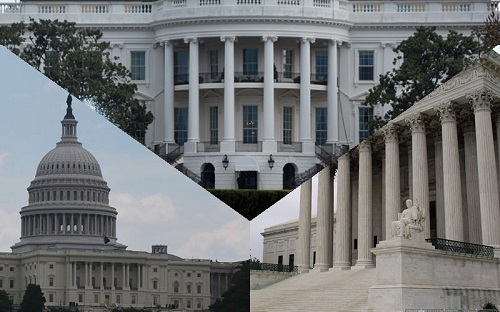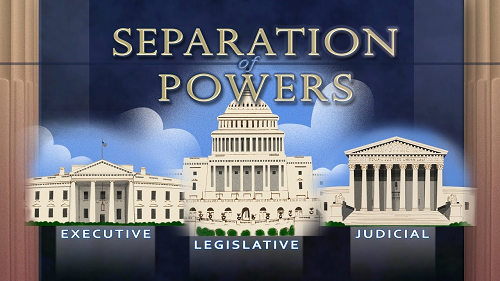Unit 4: The Three Branches of Government
Unit 4: The Three Branches of Government

Unit 4: The Three Branches of Government

Unit 4: The Three Branches of Government
The three branches of the U.S. government are the legislative, executive and judicial branches. According to the doctrine of separation of powers, the U.S. Constitution distributed the power of the federal government among these three branches, and built a system of checks and balances to ensure that no one branch could become too powerful.
Separation of Powers
The Enlightenment philosopher Montesquieu coined the phrase “trias politica,” or separation of powers, in his influential 18th-century work “Spirit of the Laws.” His concept of a government divided into legislative, executive and judicial branches acting independently of each other inspired the framers of the U.S. Constitution, who vehemently opposed concentrating too much power in any one body of government.
In the Federalist Papers, James Madison wrote memorably of the necessity of the separation of powers to the new nation’s democratic government: “The accumulation of all powers, legislative, executive and judiciary, in the same hands, whether of one, a few, or many, and whether hereditary, self-appointed, or elected, may justly be pronounced the very definition of tyranny.”
Legislative Branch
According to Article I of the Constitution, the legislative branch (the U.S. Congress) has the primary power to make the country’s laws. This legislative power is divided further into the two chambers, or houses, of Congress: the House of Representatives and the Senate.
Members of Congress are elected by the people of the United States. While each state gets the same number of senators (two) to represent it, the number of representatives for each state is based on the state’s population.
Therefore, while there are 100 senators, there are 435 elected members of the House, plus an additional six non-voting delegates who represent the District of Columbia as well as Puerto Rico and other U.S. territories.
In order to pass an act of legislation, both houses must pass the same version of a bill by majority vote. Once that happens, the bill goes to the president, who can either sign it into law or reject it using the veto power assigned in the Constitution.
In the case of a regular veto, Congress can override the veto by a two-thirds vote of both houses. Both the veto power and Congress’ ability to override a veto are examples of the system of checks and balances intended by the Constitution to prevent any one branch from gaining too much power.
 Executive Branch
Executive Branch
Article II of the Constitution states that the executive branch, with the president as its head, has the power to enforce or carry out the laws of the nation.
In addition to the president, who is the commander in chief of the armed forces and head of state, the executive branch includes the vice president and the Cabinet; the State Department, Defense Department and 13 other executive departments; and various other federal agencies, commissions and committees.
Unlike members of Congress, the president and vice president are not elected directly by the people every four years, but through the electoral college system. People vote to select a slate of electors, and each elector pledges to cast his or her vote for the candidate who gets the most votes from the people they represent.
In addition to signing (or vetoing) legislation, the president can influence the country’s laws through various executive actions, including executive orders, presidential memoranda and proclamations. The executive branch is also responsible for carrying out the nation’s foreign policy and conducting diplomacy with other countries, though the Senate must ratify any treaties with foreign nations.
Judicial Branch
Article III decreed that the nation’s judicial power, to apply and interpret the laws, should be vested in “one supreme Court, and in such inferior Courts as the Congress may from time to time ordain and establish.”
The Constitution didn’t specify the powers of the Supreme Court, or explain how the judicial branch should be organized, and for a time the judiciary took a back seat to the other branches of government.
But that all changed with Marbury v. Madison, an 1803 milestone case that established the Supreme Court’s power of judicial review, by which it determines the constitutionality of executive and legislative acts. Judicial review is another key example of the checks and balances system in action.
Members of the federal judiciary—which includes the Supreme Court, 13 U.S. Courts of Appeals and 94 federal judicial district courts—are nominated by the president and confirmed by the Senate. Federal judges hold their seats until they resign, die or are removed from office through impeachment by Congress.
This unit emphasizes the basic principles of political organization embodied in the Constitution and the processes by which power is passed on within all levels of the three branches of government.
Unit Focus
- Duties, responsibilities, and powers of each branch of government
- Election and appointment procedures for each branch of government
- Steps by which a bill becomes a law
- How power is transferred in each branch of government
- Ways national leaders may be removed from office
Vocabulary
Lesson Reading
Videos and Interactives (Click on Images to View Content)

